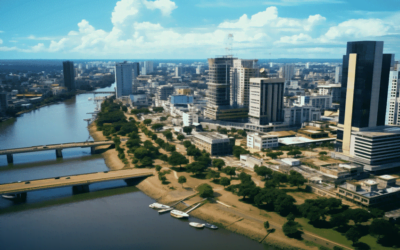Hey there, fellow drone enthusiasts! If you’ve found your way here, I can totally relate to what brought you searching for “Serbia Drone Laws.” It can be a maze trying to navigate the ever-changing world of drone regulations, and I know just how important it is to get the right information. So, trust me, I’ve got your back!
You see, I’ve been on a quest—a deep dive into Serbia’s drone laws, uncovering the nitty-gritty details, and connecting the dots to help you understand the ins and outs.
I’ve pored over the official documentation, spoken to experts, and explored every nook and cranny of these regulations. I wanted to make sure that when you came here looking for answers, you’d find exactly what you needed. The journey has been fascinating, and I can’t wait to share all that I’ve learned.
Now, I know you’re here for a reason, and I’m probably looking for clarity on how to fly your drone legally in Serbia. Well, you’re in the right place! In the pages ahead, I’m going to break down the Serbia Drone Laws for you, offering insights and practical advice.
So, stick around, and together, we’ll navigate the drone-friendly skies of Serbia with confidence and ease. Let’s get started!
- Regulatory Authority in Serbia
- Drone Categories in Serbia
- General Rules for Drone Operations in Serbia
- Serbia Drone Registration and Documentation
- Government Drone Operators in Serbia
- Drone Regulations for Visitors to Serbia
- Commercial Drone Laws for Residents in Serbia
- Hobbyist Drone Laws for Residents in Serbia
- Final Thoughts on Serbia Drone Laws
- Frequently Asked Questions About Serbia Drone Laws
Regulatory Authority in Serbia

Now, let’s dive into the heart of the matter: understanding who’s in charge of the dronescape in Serbia. When it comes to the regulation of drones, it’s the Civilian Aviation Directorate (CAD) that takes the pilot’s seat. They’re the authority ensuring everything flies in line with the rules, keeping the skies above Serbia safe and sound.
The Role of Serbia’s Civilian Aviation Directorate (CAD)
The CAD, the main player in the drone regulation game, wears the captain’s hat when it comes to ensuring that all drone operations in Serbia follow the law. Picture them as the guardians of the airspace, with a mission to maintain safety, security, and order in the friendly skies of this beautiful country.
Now, it’s not just about overseeing the drone drama; the CAD sets the rules and guidelines to make sure everything runs smoothly. They decide what you can and can’t do with your drone.
If you’re planning a flight or want to understand the nitty-gritty details of Serbia’s drone laws, the CAD is your go-to source. They’re like the air traffic controllers of the drone world, ensuring all pilots, from hobbyists to professionals, follow the rules of the game.
Link to Official Serbia Drone Regulations for Reference
To make life easier for drone enthusiasts and pilots, the CAD provides a direct link to the official Serbia Drone Regulations. This link is your gateway to the rulebook that you absolutely need to know before taking your drone out for a spin.
Imagine it as your pilot’s manual, complete with all the dos and don’ts of drone operation in Serbia. It’s the compass to keep you on the right flight path.
So, whenever you need to cross-check or delve into the specifics, just a click away, and you’ll have the CAD’s official regulations at your fingertips. It’s like having an experienced co-pilot guide you through every flight, ensuring you’re in compliance with Serbia’s drone laws.
The CAD’s role in regulating drones in Serbia isn’t just about rules; it’s about creating a safe and enjoyable environment for drone enthusiasts. So, remember, they’re your go-to source for all things drone-related in this beautiful country.
Also Read: Senegal Drone Laws 2024
Drone Categories in Serbia

Now, let’s get down to the nuts and bolts of Serbia’s drone laws. You see, when you’re a drone enthusiast, one thing you must wrap your head around is the categorization of these flying machines. It’s kind of like understanding different classes of vehicles on the road but with a drone twist. Let me break it down for you.
Explanation of the Four Drone Categories
In Serbia, drones come in four distinct flavors, and they’re categorized based on their weight and intended use. It’s like a menu of choices, and each one comes with its own set of rules.
First up, we have Category 1, which includes those tiny drones with a maximum take-off weight of less than 0.9 kg. Think of them as the lightweight champions of the drone world.
Moving up the ladder, we have Category 2, which covers drones weighing between 0.9 kg and 4 kg (but not including 4 kg). These are a bit beefier and are used for various purposes, including recreational flying and small-scale commercial tasks.
Category 3 takes us into the mid-weight range, spanning drones with a maximum take-off weight of 4 kg to 25 kg (excluding 25 kg). These are the workhorses, often used for more serious professional tasks like aerial surveys.
Lastly, we have Category 4, where the big boys reside. These drones weigh between 25 kg and 150 kg and can tackle some heavy-duty work, making them the heavyweights of the drone family.
Importance of Categorization for Drone Operators
Now, you might be wondering, Why does this categorization matter? Well, my drone-loving friend, it’s crucial because it determines which set of rules you’ll be playing by.
Each category comes with its own requirements and limitations, ensuring that your drone operations are safe and legal. Whether you’re a hobbyist, a pro, or somewhere in between, knowing your drone’s category is like having the right key for the right lock.
It helps you understand what you can and can’t do, so you can soar into the Serbian skies with confidence and knowledge. So, before you take off, it’s essential to know your drone’s category, and trust me, it’s a small step that can make a world of difference in your drone adventures.
Also Read: Scotland Drone Laws 2024
General Rules for Drone Operations in Serbia

Now, here’s where it gets real. We’re diving into the bread and butter of Serbia’s drone laws—the nitty-gritty rules that every drone pilot needs to know. Whether you’re a seasoned pro or just getting started, these are the rules that’ll keep you soaring smoothly through the Serbian skies.
Registration Requirements for All Drones in Serbia
First things first, and this is crucial, no matter what category your drone falls into, you’ve got to register it. Yep, just like you’d register your car if you were cruising the streets. This registration process is your drone’s official entry ticket into the world of Serbian airspace.
It’s all about keeping track of who’s who in the drone world, ensuring accountability, and, most importantly, safety. So, before you launch your drone, make sure it’s officially on the books with the Civil Aviation Directorate (CAD).
Need for Permission from CAD for Each Drone Flight
Here’s a big one – every time you want to send your drone up into the skies of Serbia, you need a thumbs-up from the CAD. It’s like having an air traffic controller give you the green light.
They need to know where and when you’ll be flying, and they’ll assess if it’s all good from a safety standpoint. The catch is, that this isn’t an instant process.
You’ve got to request this permission well in advance—up to five business days before your planned flight. So, if you’re thinking of capturing some breathtaking aerial shots or simply enjoying the thrill of flying, a little pre-planning is in order.
Specific Rules for Serbian Citizens, Including Aerial Filming Permits
If you’re a citizen of the Republic of Serbia, you have the option to apply for an aerial filming permit. This is your golden ticket to capture some epic drone footage of the beautiful landscapes of Serbia. However, there’s a twist here.
You can’t just apply for this permit as an individual. Nope, you’ve got to go through a legal entity that’s registered within Serbia. So, if you’re planning to turn those drone adventures into cinematic masterpieces, this is the route you’ll need to take.
Rules for Non-Serbian Citizens and Foreigners Operating in Serbia
Now, what if you’re not a Serbian citizen, but you’ve got your drone and you’re eager to explore Serbia from above? Well, the rules are a bit different for you.
As a non-Serbian citizen, you can apply for an aerial survey permit for your drone, but there’s a catch – you still need to do it through a legal entity that’s registered in Serbia.
It’s all about ensuring that the drone operations within Serbia are accountable and comply with the local regulations. So, for our drone enthusiast friends from other parts of the world, it’s a bit of paperwork, but the stunning views of Serbia from the sky are totally worth it.
No-Fly Zones, Including a Minimum Distance from Airports
Alright, folks, let’s talk about no-fly zones. Just like with any adventure, there are some places you should steer clear of with your drone in Serbia.
One of the significant no-no areas is around airports. You’ve got to keep a minimum of 5 kilometers away from these aerial hubs. It’s all about safety and preventing any unwanted surprises for the pilots of those massive flying machines. So, remember, if an airport’s in the vicinity, keep your drone grounded.
Daylight Flying Restrictions and Altitude Limits
Now, we all love those golden hours of dawn and dusk for capturing stunning shots, but when it comes to drone flying in Serbia, there’s a bit of a catch. The rule is simple: stick to flying during daylight hours.
It’s a safety thing; you need good visibility to keep your drone safe. And, speaking of safety, the maximum altitude you can reach is 100 meters above the ground. This keeps things predictable and avoids any mishaps in the skies.
Maintaining Visual Line of Sight and Safety Distances
Visual line of sight—it’s a must in Serbia when you’re piloting your drone. You’ve got to keep an eye on your drone at all times. Imagine it like a string connecting you to your drone, and you should always be able to see it.
This ensures that you can react quickly to any changes in your surroundings, keeping things safe and under control.
Additionally, you need to maintain a 500-meter buffer zone between your drone and yourself. It’s like giving your drone some personal space, ensuring that you have enough room to react and make decisions without feeling crowded.
Prohibitions on Operating Drones Under the Influence
Last but not least, let’s talk about responsibility. Just like you wouldn’t drive a car under the influence, the same goes for your drone. Operating a drone while intoxicated or under the influence of psychoactive substances is a big no-no in Serbia. It’s all about ensuring that your drone operations are clear-headed and safe. So, if you’re planning a flight, make sure you’re in your best state of mind. Safety first, always!
Also Read: Saudi Arabia Drone Laws 2024
Serbia Drone Registration and Documentation

Alright, let’s talk paperwork. It might not be the most exciting part of drone flying, but it’s essential. Registering your drone and having the right documentation is like getting your passport to explore the Serbian skies. So, let’s get into the details.
Requirements for Registering Drones in Serbia
Drone registration in Serbia isn’t overly complex, but there are some key requirements to follow. You need to provide proof of customs duties paid if your drone was manufactured outside Serbia.
If that proof isn’t available, you can submit a document proving your ownership of the drone. And don’t forget to include the manufacturer’s instruction manual in Serbian or English; it’s like the user guide for your drone.
Lastly, a liability insurance contract is a must to cover any damage to third parties resulting from your drone’s operation, as per the laws governing compulsory insurance in transportation. These requirements ensure that every drone operator is accountable and safe in the Serbian skies.
Documentation Necessary for the Registration Process, Including Customs Duties and Insurance
When it comes to documentation for drone registration, you need to cover your bases. If your drone was made in another country, you’ll need proof that you’ve paid the customs duties. If you can’t provide this, a document proving ownership will do the trick.
It’s like having a receipt for your drone. Also, make sure you have the manufacturer’s instruction manual in Serbian or English. It’s your guide to using the drone safely.
And finally, that all-important liability insurance contract is a must. It’s like having an insurance policy for your drone adventures, ensuring you’re responsible and ready to cover any potential mishaps.
Special Considerations for Amateur-Built Unmanned Aircraft
Now, if you’ve ventured into the realm of building your own drone, there are a few additional considerations. You’ll need an endorsed written statement from the person who built the aircraft and documentation proving ownership if you’re not the builder.
It’s like vouching for your DIY skills. Safety is the name of the game, and Serbia wants to ensure that even homemade drones are up to par. So, this documentation ensures that your amateur-built drone is good to go.
Technical Documentation and Demonstration Flight Requirements for Category 4 Drones
For the big boys in Category 4, things get a bit more technical. If you’re operating a drone in this weight class, you’ll need to submit technical documentation to prove that your drone can fly safely. This is like your drone’s certification for the heavyweight division.
You’ll also need to demonstrate a test flight in the presence of an authorized officer from the Directorate to prove that your drone can handle its weight class. It’s all about safety and accountability, making sure that Category 4 drones can soar into the Serbian skies without any issues.
Also Read: Sao Tome and Principe Drone Laws 2024
Government Drone Operators in Serbia

Government drone operators have their own set of rules to follow in Serbia. It’s all about ensuring that when the government sends its drones into the sky, everything is done safely and by the book. Let’s break it down.
Regulations for Government Drone Flights in Serbia
When it comes to government drone flights, there are specific regulations in place. The government is allowed to use drones in Serbia, but it’s not free for all. There are still rules to follow.
These rules ensure that government drone operations are in line with safety and security standards. It’s about making sure that when government drones take flight, they do so responsibly and within the boundaries of the law.
Requirements for Government Drone Pilots, Registration, and Insurance
Just like everyone else, government drone pilots need to meet certain requirements. They need to register their drones, and it’s not just about the paperwork. Government drone pilots also need to ensure they have the necessary insurance coverage in place.
This insurance is there to cover any potential damage or incidents that might occur during government drone operations. It’s all about accountability and ensuring that government drone flights are safe and secure. So, even when the government takes to the skies with drones, they’re still playing by the same rules as the rest of us.
Also Read: San Marino Drone Laws 2024
Drone Regulations for Visitors to Serbia

Now, let’s talk about all you wanderlust-driven drone enthusiasts out there planning to explore Serbia. It’s a beautiful country, and capturing its essence from the sky is a dream come true. But, before you pack your drone and hop on a plane, there are a few important things you need to know about flying your drone as a visitor in Serbia.
Guidelines for Foreign Visitors and Tourists Flying Drones in Serbia
Alright, first things first. If you’re a foreign visitor or tourist itching to fly your drone in Serbia, it’s not as simple as just showing up and taking off. You’ll need to follow some guidelines to ensure that your drone adventures are legal and safe.
That means getting a drone pilot license and registering or authorizing your drone. It’s like getting your travel visa—you need the right documentation to explore the Serbian skies. So, don’t forget to check these off your list before you launch.
The Necessity of a Drone Pilot License and Registration/Authorization
Now, about that drone pilot license—it’s a requirement for all drone operators, regardless of whether you’re a local or a visitor. It ensures that you have the knowledge and skills to operate your drone safely.
And when it comes to registration or authorization for your drone, it’s all about accountability and keeping track of who’s flying in Serbian airspace. The rules are in place to make sure that drones are operated responsibly, whether you’re a local or just passing through.
Recommendations for Drone Insurance While Visiting Serbia
While it’s not a strict requirement, having drone insurance is highly recommended, especially if you’re visiting Serbia. Accidents can happen, and it’s better to be prepared. This insurance covers any potential damage or incidents that might occur during your drone flights.
It’s like having a safety net for your drone adventures. So, if you’re planning to capture the beauty of Serbia from above, consider investing in drone insurance to ensure your peace of mind while you’re exploring this stunning country.
Also Read: Samoa Drone Laws 2024
Commercial Drone Laws for Residents in Serbia

If you’re a resident of Serbia and you’re looking to turn your drone hobby into a business venture, it’s important to understand the commercial drone laws in the country. Let’s dive into what you need to know.
Overview of Regulations for Commercial Drone Operations in Serbia
When it comes to operating drones commercially in Serbia, there’s a framework in place to ensure that everything runs smoothly and safely. It’s all about striking a balance between fostering innovation and maintaining safety.
Commercial drone operators are an essential part of various industries, from photography and videography to surveying and agriculture. The regulations are in place to provide a structured environment where these businesses can thrive while upholding the safety and privacy of the public.
Licensing, Registration, and Insurance Requirements for Commercial Drone Operators
If you’re thinking of going commercial with your drone, you’ll need to check all the boxes. First and foremost, you’ll need a commercial drone pilot license. This license ensures that you have the necessary knowledge and skills to operate drones safely in a professional setting.
Additionally, registering your drone is crucial, just like for recreational operators. But here’s where it gets a bit more intense – you may need insurance. While it’s not an absolute requirement, having drone insurance is highly advisable for commercial operations.
It protects you and your clients from any potential mishaps that might occur during your drone services.
So, whether you’re capturing breathtaking aerial footage for clients or providing surveying services, make sure you’re up to date with all the necessary licenses, registrations, and, if needed, insurance to keep your drone business above the clouds.
Also Read: Saint Vincent and the Grenadines Drone Laws 2024
Hobbyist Drone Laws for Residents in Serbia

Calling all drone enthusiasts who fly purely for the thrill and fun of it, let’s talk about the hobbyist drone laws in Serbia. Whether you’re into capturing epic landscapes or just exploring the world from above, there are some essential rules to follow.
Regulations and Categories for Hobbyist Drone Operators in Serbia
If you’re flying drones as a hobby in Serbia, you’ll still need to navigate through the regulations. Drones are categorized based on their weight and intended use, just like commercial and government drones.
These categories help determine the requirements for your drone operations. It’s all about ensuring that you’re enjoying your hobby safely and responsibly.
Drone Pilot Licenses and Drone Registration
For hobbyist drone operators, the rules aren’t as stringent as they are for commercial or government operators. But you’ll still need to check a couple of boxes. First, there’s the drone pilot license.
It’s like a badge that proves you know what you’re doing up there in the sky. Then, just like everyone else, you’ll need to register your drone. It’s all about keeping track of who’s flying what. So, if you’re piloting drones for fun, make sure you have these requirements squared away.
Importance of Considering Drone Insurance for Hobbyist Operations
While drone insurance isn’t mandatory for hobbyists, it’s a smart move to consider it. Accidents can happen, no matter how experienced you are. Having insurance can save you from unexpected expenses if your drone takes an unscheduled nosedive.
So, if you’re planning to embark on thrilling adventures with your drone as a hobbyist, a bit of insurance might be a good safety net to have in place. It ensures that your joyrides in the sky remain just that—joyful and worry-free
Also Read: Saint Lucia Drone Laws 2024
Final Thoughts on Serbia Drone Laws

Well, we’ve covered a lot about Serbia’s drone laws, and it’s time to wrap things up. Flying drones is an incredible experience, but it comes with responsibilities. Let’s summarize what we’ve learned and why it’s crucial to follow these regulations.
Throughout this article, we’ve delved into the various aspects of drone regulations in Serbia. From the role of the Civilian Aviation Directorate to the different drone categories, we’ve covered the essentials.
We’ve talked about registration, permissions, and even the rules for hobbyists. The key takeaway is that flying drones in Serbia is legal, but there are specific rules to ensure safety and accountability.
Emphasize the Significance of Adhering to Serbia’s Drone Laws for Safety and Legality
It’s not just about following the rules because they’re written in a book somewhere. Adhering to Serbia’s drone laws is crucial for two fundamental reasons: safety and legality.
These regulations are designed to keep the skies safe for all, prevent accidents, and protect people’s privacy. Plus, operating within the bounds of the law means you won’t find yourself in any legal hot water. So, it’s a win-win: you get to enjoy the drone hobby you love while keeping everyone safe and legal.
Drone regulations can evolve, just like technology. So, my advice to all the drone enthusiasts out there is to stay updated. The best way to do that is to keep an eye on the official sources, like the Civilian Aviation Directorate’s website.
Make it a habit to check for any updates or changes to the regulations. By staying informed, you ensure that your drone flights remain enjoyable, responsible, and within the bounds of the law. It’s all part of being a responsible drone pilot, and it’s a role we all play in keeping the skies safe and welcoming for everyone. Happy flying!
Frequently Asked Questions About Serbia Drone Laws
1. Can I fly a drone in Serbia as a foreigner?
Yes, you can fly a drone in Serbia as a foreigner, but there are specific rules to follow. You must obtain permission from the Serbian Ministry of Defense before bringing your drone into the country. Additionally, all drones must be registered with the Serbian government, and you need permission from the Civilian Aviation Directorate (CAD) for each flight.
2. Do I need a drone pilot license to fly in Serbia?
Yes, in Serbia, both local and foreign drone operators need a drone pilot license. This license ensures that you have the knowledge and skills required to operate a drone safely. It’s a necessary requirement to fly legally.
3. What are the different drone categories in Serbia?
Serbia categorizes drones based on their weight and intended use. There are four categories:
Category 1: Drones with a maximum take-off mass of less than 0.9 kg.
Category 2: Drones with a maximum take-off mass from 0.9 kg to 4 kg (excluding 4 kg).
Category 3: Drones with a maximum take-off mass of 4 kg to 25 kg (excluding 25 kg).
Category 4: Drones with a maximum take-off mass of 25 kg to 150 kg.
4. Do I need insurance to fly my drone in Serbia?
While insurance isn’t mandatory for hobbyist drone operators, it’s highly recommended. Accidents can happen, and having insurance can protect you from unexpected expenses. For commercial drone operators, insurance is advisable to safeguard your business and clients.
5. What are the no-fly zones in Serbia for drones?
It’s crucial to keep a minimum distance of 5 kilometers away from airports. Also, you should fly only during daylight hours, maintain a visual line of sight with the drone, aim for a maximum altitude of 100 meters above the ground, and keep a 500-meter distance between the drone and the pilot. Additionally, you should avoid operating drones near major infrastructure, such as power plants, government buildings, and highways, and stay at least 500 meters away from these areas. Operating a drone under the influence of drugs or alcohol is prohibited.













